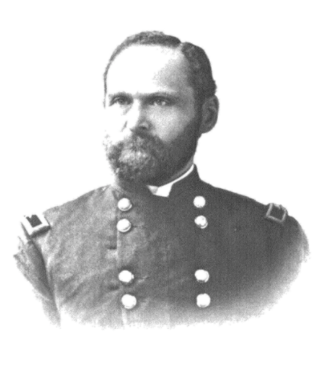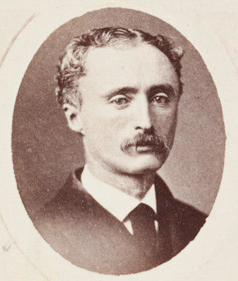
Wager Swayne was a Union Army colonel during the American Civil War and was appointed as the last major general of volunteers of the Union Army. Swayne received America's highest military decoration the Medal of Honor for his actions at the Second Battle of Corinth. He also was effectively the military governor of Alabama from March 2, 1867, to July 14, 1868, after the passage of the first Reconstruction Act by the U.S. Congress until Alabama was readmitted to the Union. Robert M. Patton remained the nominal governor during this period but as the local army commander, Swayne controlled the State government. During the Reconstruction era, Swayne oversaw the Freedmen's Bureau in Alabama and helped establish schools for African Americans in the state. He was the first person born after Alabama statehood, to govern the state.

John Irvin Gregg was a career U.S. Army officer. He fought in the Mexican–American War and during the American Civil War as a colonel and near the end of the war as a brevet general in the Union army. In 1866, he was nominated and confirmed as a brevet major general of volunteers and a brevet brigadier general in the Regular Army, both to rank from March 13, 1865.

Asa Peabody Blunt was an officer in the Union Army during the American Civil War. He remained on active duty after the war. In recognition of his service during the Civil War, he was appointed to the grade of brevet brigadier general of volunteers. Blunt was notable as commander of the 2nd Vermont Brigade and the United States Disciplinary Barracks at Fort Leavenworth, Kansas.

Aaron Simon Daggett was a career United States Army officer. He was the last surviving brevet Union general of the American Civil War, and the last surviving general of any grade from the war, when he died exactly one month shy of his 101st birthday in 1938. Daggett was nominated for appointment to the grade of brevet brigadier general, to rank from March 13, 1865, by President Andrew Johnson on February 21, 1866 and was confirmed by the United States Senate on April 10, 1866. During the war, Daggett fought at West Point, Gaines' Mill, Golding's Farm, White Oak Swamp, Second Bull Run, South Mountain, Antietam, Rappahannock Station, Fredericksburg, Battle of Gettysburg, Battle of Mine Run, Battle of the Wilderness and Battle of Cold Harbor. Daggett was a brigadier general of volunteers in the Spanish–American War. He was appointed to the brigadier general grade to rank from September 1, 1898 and was mustered out of the volunteers on November 30, 1898. He was promoted to brigadier general in the Regular Army ten days before his retirement from the army on March 2, 1901.
The 76th Ohio Infantry Regiment, sometimes 76th Regiment, Ohio Volunteer Infantry was an infantry regiment of the Union Army during the American Civil War. The regiment served in the Western Theater, primarily as part of the XV Corps in the Army of the Tennessee.

Nicholas Longworth Anderson was a United States Army officer who served in the American Civil War as Colonel of the 6th Ohio Volunteer Infantry. After the Civil War, he was nominated and confirmed for appointment to the brevet grades of brigadier general and major general of volunteers.

The 6th Ohio Infantry Regiment was a regiment in the Union Army during the American Civil War, primarily serving in the Western Theater in a series of campaigns and battles.

Gilbert Marquis LaFayette Johnson was an officer in the Union Army from Indiana during the American Civil War, reaching the rank of colonel. In 1866, he was nominated and confirmed for appointment to the grade of brevet brigadier general.
The 9th Iowa Infantry Regiment was an infantry regiment that served in the Union Army during the American Civil War.

Henry Blackstone Banning was a lawyer and three-term U.S. Representative from Ohio, as well as an infantry officer in the Union Army during the American Civil War.

Samuel Miller Quincy was the 28th mayor of New Orleans and a Union Army officer during the American Civil War.

Charles Robert Woods was a career United States Army officer and a Union general during the American Civil War. He is noted for commanding the relief troops that first attempted to resupply Fort Sumter prior to the start of the conflict, and served with distinction during the war.

Joseph Haydn Potter was a career soldier from the state of New Hampshire who served as a general in the Union Army during the American Civil War. He was twice a prisoner of war and was cited for gallantry on multiple occasions.
Joseph Conrad was a Union American Civil War colonel who was nominated and confirmed in 1866 for appointment as a brevet brigadier general of volunteers for his service during the Atlanta Campaign.
The 31st Ohio Infantry Regiment was an infantry regiment in the Union Army during the American Civil War.
The 78th Ohio Infantry Regiment, sometimes 78th Ohio Volunteer Infantry was an infantry regiment in the Union Army during the American Civil War.

The 81st Ohio Infantry Regiment, sometimes 81st Ohio Volunteer Infantry was an infantry regiment in the Union Army during the American Civil War.

Adam Gale Malloy was an Irish American immigrant and Republican politician who served as a Union Army officer during the American Civil War. After the war, he was given an honorary brevet to brigadier general. He was an unsuccessful candidate for the United States House of Representatives from Texas in 1892.

Moses B. Walker was a Union Army officer during the American Civil War.

Wells S. Jones was an American physician, politician, and soldier. He served as an infantry officer in the Union Army in the Western Theater during the American Civil War, and was breveted a brigadier general near the end of the conflict. After the war, Jones studied to become a doctor at Starling Medical College, precursor to the Ohio State University College of Medicine.














